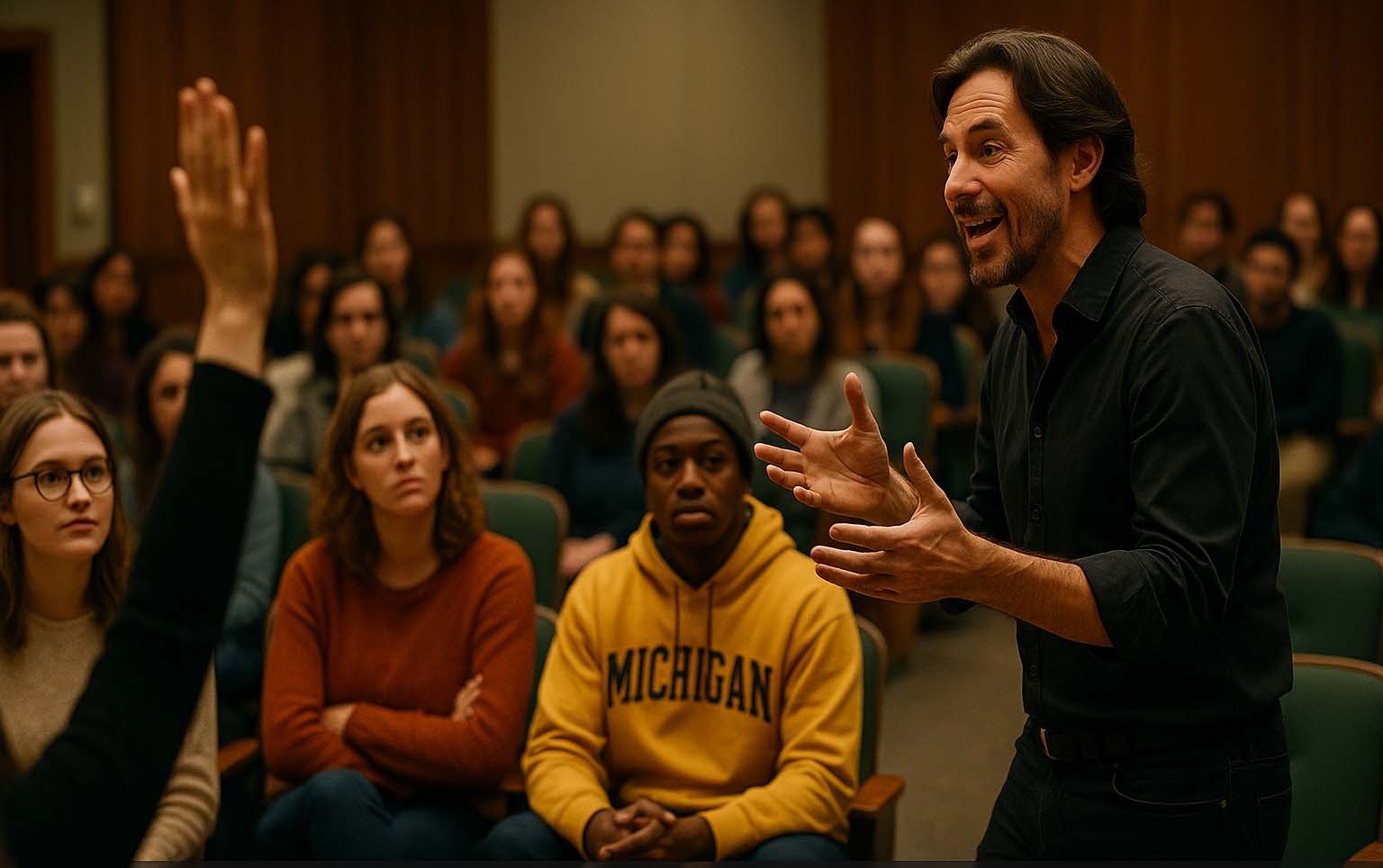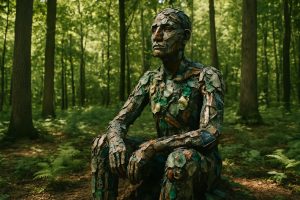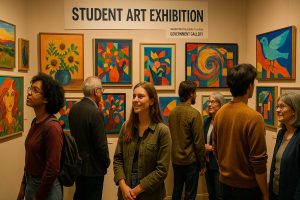
Knowledge Exchange: Why Visiting Artist Talks Matter in Michigan Universities
Art keeps transforming across regions and generations. Each creation—be it sculpture, music, or digital media—holds meaning beyond the surface. One way that meaning reaches a wider audience is through visiting artist talks. These events, hosted by universities in Michigan, offer more than lectures. They create space for dialogue, learning, and mutual appreciation between practicing artists, students, and educators.
Instead of simply talking about art theory, these sessions present firsthand creative experience. They give young artists the chance to witness how ideas take shape and evolve through various perspectives.
- Artist talks allow students and communities to interact with working artists from around the world.
- Sessions go beyond technique, touching on cultural identity, global events, and personal journeys.
- They help students connect their own work to wider social and creative landscapes.
A Platform That Builds Bridges
Artist talks are now regular components of many art programs, especially in Michigan. These events draw painters, sculptors, digital creators, and performance artists from abroad. Students often hear perspectives shaped by real experiences—from migration stories to environmental activism.
Instead of simply reading about global issues, they get to ask questions directly from the artists. This leads to deeper conversations in and beyond the classroom. And since many talks are open to the public, they also bring local communities into the learning process.
Learning With a Human Touch
While technology brings convenience, nothing compares to the energy of in-person dialogue. In a live artist talk, the artist becomes a storyteller. Their creative path, struggles, and successes feel more immediate and relatable.
For instance, a sculptor from West Africa might share how she uses discarded materials to speak on waste and sustainability. A visual artist from Turkey might walk students through a mural project that reshaped her town’s public spaces. These are real stories that turn abstract topics into something visible and alive.
Strengthening Michigan’s Creative Ecosystem
From Ann Arbor to Grand Rapids, Michigan has a rich tradition of supporting visiting artists. Many universities have formed long-standing partnerships with galleries and arts organizations. These connections help bring in international voices that challenge, inspire, and inform.
The ripple effects can be seen in student projects. An undergraduate might shift their thesis topic after attending a talk. Another might begin exploring their cultural heritage through painting after listening to an artist speak about generational memory.
Stories That Leave a Mark
One standout example involved a South Korean textile artist invited to speak at a university. Her presentation blended culture, craft, and personal history. She described how she reinterprets traditional fabrics to reflect modern life. Beyond the technical detail, she shared personal challenges—like balancing family expectations with her work as a woman in a male-dominated field.
Her honesty moved the audience. A few weeks later, students launched their own research project on labor history using fabric collage. What began as a single event turned into months of hands-on research and community interviews.
When Art Reflects Social Reality
Visiting artists don’t just bring beauty; they also bring truth. Some address topics like inequality, racism, or migration. A mixed-media artist from the U.S. once shared how she created installations exploring police violence in urban neighborhoods. Her stories sparked emotional reactions and meaningful discussion among students.
These events often lead to questions that aren’t easy to answer. But that’s the point. Instead of offering solutions, they encourage reflection. Students begin to understand that art isn’t only visual—it’s also emotional, political, and deeply human.
Behind the Scenes: Coordinating a Visit
Hosting an artist involves much more than booking a flight. Michigan universities assign dedicated faculty or curators who handle logistics, artist selection, and programming. They ensure that the guest artist’s background aligns with current course themes or student interests.
Talks are often paired with exhibits, critiques, or workshops. These added activities offer participants more time to connect with the artist. Some workshops focus on skill-building, while others emphasize concept development or experimentation.
Beyond Local: Building International Ties
When a university brings in an artist from abroad, both sides benefit. The institution gains fresh insight. The artist gets access to resources, collaboration opportunities, and a new audience.
These interactions sometimes evolve into lasting relationships. Artists may invite students to assist in future exhibitions or join residencies abroad. A small talk in Michigan can lead to new exhibits in Seoul, Berlin, or Nairobi. These connections prepare students to enter a truly global creative space.
Voices From the Classroom
Students consistently say they gain more from these talks than from textbooks. The opportunity to hear real stories from real people often reshapes how they see their craft. It builds confidence, encourages experimentation, and makes their artistic vision feel more grounded.
Some have even described these events as pivotal. For instance, one senior student said that meeting a visiting artist gave her the courage to apply for graduate school in another country—a path she hadn’t considered until that day.
Extending the Reach Beyond Campus
Artist talks shouldn’t stay within campus walls. Some Michigan institutions now invite local high school teachers, librarians, and community leaders to attend. Others organize public forums in libraries, museums, or parks, ensuring that art remains part of everyday life.
These efforts help broaden the discussion. They include people from diverse backgrounds and age groups. Everyone gets to hear different perspectives and share their own.
Conversations That Spark Long-Term Change
What makes these events memorable is their ability to turn knowledge into action. When students see art intersect with real-life issues, their own projects become more thoughtful. They begin to work with greater intention. They consider their materials, their audience, and their impact more seriously.
Even for those who won’t pursue art professionally, these talks foster empathy and critical thinking. They challenge assumptions and remind people that stories can be told in more than one way.
A Growing Need for Support
Though the impact is clear, many of these programs face challenges—especially when it comes to funding and institutional support. Faculty often rely on external grants or temporary sponsorships to cover artist fees, travel, and materials.
Sustained investment can help scale these efforts. Imagine more talks happening in smaller colleges, community centers, and public libraries. These spaces could host guest artists who specialize in lesser-known fields like traditional weaving, calligraphy, or experimental sound design.
Art That Lives in Conversation
In today’s fast-paced world, people often scroll through content without reflection. But when they sit down to listen to someone speak from the heart, something changes. These talks remind everyone that art is not a product—it’s a process. It’s not always polished. Sometimes it’s messy, uncertain, or deeply personal.
Through visiting artist talks, art education becomes dynamic. Students don’t just study—they participate. They create. They connect.
Why These Talks Matter
They may last only an hour or two, but the effect of a visiting artist talk can last a lifetime. These sessions encourage deeper engagement. They foster real relationships between creators and learners. And they promote an environment where creativity is not limited to the studio—it’s woven into daily life.
By listening, observing, and asking questions, students develop into more thoughtful artists and citizens. They begin to understand the full role that art can play—not only in galleries but in classrooms, neighborhoods, and the wider world.

